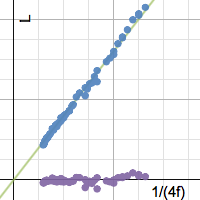Playing with Transformers & Building an AC to DC Converter
My one remaining IB Physics HL student was alone in class today, so I made a quick switch on plans to do one of the required activities in the syllabus: building a full-wave rectifier circuit. This was also an opportunity to play with transformers (no, not that kind of transformer) which I presented last class as a really useful application of electromagnetic induction:

I did almost nothing during the whole class period, aside from giving instructions and asking questions. With wires, resistors, and other circuit parts all over the place, this was not a well organized lab, but that doesn’t matter. Here’s what we did:
- Measure the AC voltage and frequency coming out of the supply
- Connect the supply to one of the transformer coils, and place the other coil inside. Measure the voltage and frequency on the secondary coil. Comment on the number of coils on the primary and secondary. Observe the effect of inserting an iron core into the transformer.
- Predict what would happen if the two coils were switched, then measure to compare with prediction.
- Build a half-wave rectifier circuit with a diode and resistor using the secondary coil as a supply. Measure the voltage wave form.
- Build a full-wave rectifier circuit, and measure the voltage signal across a resistor. Check this out:

- Connect a capacitor in parallel with the resistor.

As we had hoped, the ripples are almost gone!:
In the final step, I connected a 5V regulator to the output and showed that this would be a way to make a cell phone charger if we had the right USB connector.
This is quite possibly the most satisfying and successful ‘let’s build something’ lab I’ve done with students. It fit neatly within a class period, including the clean up time. Granted, things would be different if there were multiple groups going through the process, but I’ll just ignore that fact because it’s a Friday.






















